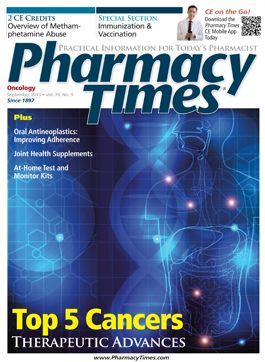Publication
Article
Pharmacy Times
Joint Health Supplements
Author(s):
The nutritional supplements glucosamine and chondroitin have demonstrated some potential for reducing pain associated with osteoarthritis
The nutritional supplements glucosamine and chondroitin have demonstrated some potential for reducing pain associated with osteoarthritis.
An estimated 27 million individuals in the United States suffer from osteoarthritis (OA)—a prevalent, slowly progressive, chronic form of arthritis characterized by the breakdown and eventual loss of the joint’s cartilage due to injury or normal wear and tear.1-3
Cartilage is an important part of the joint that cushions the ends of the bones and enables the joints to move easily.1-3 Once cartilage starts to break down, the bones rub against one another, causing pain, stiffness, and loss of movement/flexibility in the joint.1,2 Patients at risk for OA often become symptomatic between 40 and 60 years of age (Online Tables 1 and 2).4 OA in individuals younger than 40 years is typically the result of an injury or trauma.4
Table 1: Factors that May Increase the Risk for Osteoarthritis1
- Older age
- Being overweight or obese
- Sedentary lifestyle
- History of injury
- Overactivity due to exercise
- Familial history of osteoarthritis
- Muscle weakness
Treatment of OA generally involves physical therapy, drug therapy, and lifestyle modifications, such as weight loss, if warranted. Although many individuals affected by OA use traditional analgesics, some individuals elect to use various nonprescription supplements marketed for OA and joint health that contain the dietary supplements glucosamine and chondroitin sulfate. These supplements, which may be taken separately or together, have gained popularity in recent years. Studies report that glucosamine and chondroitin supplements appear to be relatively safe and well tolerated when used appropriately.5,6 Joint health supplements are formulated to support and protect healthy joint cartilage, serve as an alternative treatment for OA, and are marketed as single-entity or combination products.
Table 2: Examples of Common Signs and Symptoms of Osteoarthritis1
- Joint soreness after extended periods of overuse or inactivity
- Episodes of stiffness after periods of rest that goes away rapidly when activity resumes
- Morning stiffness, which typically lasts no more than 30 minutes
- Episodes of pain caused by weakening of muscles surrounding the joint due to inactivity or a sedentary lifestyle
- Joint pain that is typically less painful in the morning but worse in the evening after a day’s activity
- Deterioration of coordination, posture, and walking due to pain and stiffness
Glucosamine and Chondroitin
According to the National Institutes of Health National Center for Complementary and Alternative Medicine (NCCAM), in recent years, glucosamine and chondroitin have demonstrated some potential for reducing pain associated with OA, although there are still conflicting results and there is no conclusive scientific evidence regarding the exact effectiveness of these supplements.6
The Glucosamine/Chondroitin Arthritis Intervention Trial (GAIT), which was cosponsored by the NCCAM and the National Institute of Arthritis and Musculoskeletal and Skin Diseases, evaluated the effectiveness and safety of glucosamine and chondroitin when taken together or separately.5,6 The trial concluded that the combination of glucosamine and chondroitin did not provide significant relief from pain associated with OA among all participants.6 However, a subgroup of study participants with moderate to severe pain reported significant relief with the combination.6
Glucosamine and chondroitin are classified as natural substances found in and around the cells of cartilage.7 Glucosamine is classified as an endogenous mucopolysaccharide that the body produces and distributes in cartilage and other connective tissue, and chondroitin sulfate is classified as a complex carbohydrate that helps cartilage retain water.7-10 In the United States, glucosamine and chondroitin are sold as dietary supplements, which are regulated as foods rather than drugs.6,7 These supplements are available as single-entity formulations but are most often found in combination formulations.
Glucosamine
Glucosamine is believed to maintain and strengthen cartilage for overall mobility and support.7-9 Glucosamine is used by the body as a precursor for cartilage synthesis and may also serve as a sulfur donor for the sulfur bonds used in the production of cartilage.7 Research also states that glucosamine is essential to keep cartilage tissue lubricated and to maintain its naturally slippery texture.7-9 Some studies have demonstrated that glucosamine may slow the progression of knee cartilage degradation and increase cartilage growth in some individuals.7-9
Glucosamine supplements are marketed to slow the deterioration of cartilage, relieve pain associated with OA, and improve joint motility.8 Glucosamine is typically given in doses of 1500 mg daily.7 Patients should be advised that glucosamine will not provide pain relief as quickly as analgesics such as nonsteroidal anti-inflammatory drugs and APAP. Glucosamine may take 6 to 8 weeks to exhibit a therapeutic effect; continued use of analgesics, if appropriate and if no contraindications, may be needed.7 The full effects of glucosamine may take as long as 4 to 6 months to be realized.7
The most common adverse effects include nausea, upset stomach, constipation, and diarrhea.7 Adverse effects can be minimized by taking glucosamine in divided doses.7 Pregnant and lactating women should avoid the use of this supplement due to lack of clinical safety data.7 Clinical studies have shown that glucosamine may raise blood pressure and cholesterol levels as well as exacerbate asthma in some individuals, but the clinical results are inconclusive.7-9 Researchers report that glucosamine may interact with anticoagulants such as warfarin, so caution should be observed when both products are used.7-9
In addition, there is conflicting scientific evidence regarding the effects of glucosamine on glucose metabolism. Some studies report that glucosamine may elevate blood glucose levels in patients with type 2 diabetes mellitus, so patients should consult their primary health care provider prior to using supplements that contain glucosamine.5-9 Some studies report, however, that for most diabetic patients taking glucosamine, routine blood glucose testing appears to be an effective monitoring parameter to detect elevated blood glucose levels.5-9 In addition, because glucosamine supplements are often derived from shells of shrimp, lobsters, or crabs, patients with seafood allergies should avoid the use of these supplements.5-9
Chondroitin
Chondroitin sulfate is classified as a glycosaminoglycan that is normally present in cartilage.7 Chondroitin acts as a building material in cartilage production, stimulates chondrocytes to produce cartilage, and serves as a sulfur donor, which is a key function in the synthesis of cartilage.7 As a supplement, chondroitin is utilized primarily for treating OA and promoting joint health; it is marketed to reduce pain and inflammation, improve joint function, and slow the progression of OA.9-11 Usually, chondroitin is found in products that contain glucosamine as well. In supplements, chondroitin is usually derived from bovine trachea or pork by-products.7,9-11 The typical dose of chondroitin is 1200 mg once daily or in divided doses.7 Many clinical studies have concluded that this supplement needs to be taken for 2 to 4 months before patients experience any health benefits.7,10 If no relief is observed after 3 to 5 months, many health experts advise discontinuation of therapy.7
Common adverse effects include nausea and mild gastrointestinal upset.7 Chondroitin should be taken with food if upset stomach occurs. Chondroitin use should be avoided in pregnant or lactating women due to lack of clinical safety data in these patient populations.7 Patients should be advised to consult their primary health care provider before taking chondroitin because it may interact with anticoagulants.7,10 Chondroitin is not recommended for use in children.
Recommendations
The Arthritis Foundation recommends that individuals with knee OA discuss the use of glucosamine and chondroitin with their physicians to ascertain whether these supplements would be appropriate and beneficial to their treatment plan.12 In addition, the American College of Rheumatology 2012 guidelines for hand and knee OA do not recommend the use of these supplements for initial management in individuals with knee OA. The current guidelines can be found at www.rheumatology.org/Practice/Clinical/Guidelines/Osteoarthritis/.13
New joint health supplements include Osteo Bi-Flex Triple Strength (Rexall Sundown, Inc; which contains chondroitin, MSM, and 5-LOXIN Advanced) and Osteo Bi-Flex Joint and Energy (Rexall Sundown, Inc; which contains 5-LOXIN and B vitamins). 5-LOXIN is concentrated extract of Boswellia serrata, which is used to manage joint flareups.13 Other new supplements include Flex A Min Glucosamine Chondroitin MSM Triple Strength (United States Nutrition, Inc) and Schiff’s Move Free Ultra Omega (RB, LLC).
During counseling, patients should be advised of nonpharmacologic measures that may help promote healthy joints, such as losing weight (if needed; excess weight can put stress on the knees), staying active, and maintaining a healthy and balanced diet. Patients’ medical, medication, and allergy histories should be screened for potential contraindications prior to using these supplements. Patients should also be advised to seek counsel from their primary health care provider before using these supplements, especially if they have a preexisting medical condition and/or are taking medications (to avoid potential interactions with drugs).
Because many of these supplements contain other ingredients, patients should be advised to read all labels prior to use and to adhere to manufacturer-recommended warnings and directions. The Handbook of Nonprescription Drugs classifies glucosamine and chondroitin with a pregnancy risk category C; therefore, individuals who are pregnant or planning to conceive should avoid these supplements.14 Patients at risk for OA or who exhibit signs of OA should be encouraged to discuss the various treatment options to determine which is best.
Examples of Nonprescription Joint Support Supplements
- Osteo Bi-Flex Regular Strength
- Osteo Bi-Flex One Per Day
- Osteo Bi-Flex Triple Strength
- Osteo Bi-Flex Triple Strength with Vitamin D
- Osteo Bi-Flex Joint and Bone
- Osteo Bi-Flex NutraJoint Drink Mix
- Nature Made TripleFlex
- Natrol Glucosamine and Chrondroitin Tablets
- Flex A Min Maximum Strength
- Flex A Min Triple Strength
- Flex A Min Complete Double Strength
- Nature’s Bounty Glucosamine/Chondroitin Complete
- Cosamin DS Joint Health Supplement
- Cosamin ASU Advanced Formula Joint Health Supplement Capsules
- Schiff Glucosamine
- Schiff Move Free Advanced
- Schiff MegaRed Joint Care Dietary Supplement
- i-flex Joint Relief
- Emergen C Joint Health Tabs
Ms. Terrie is a clinical pharmacy writer based in Haymarket, Virginia.
References
1. Osteoarthritis. Arthritis Foundation website. www.arthritis.org/conditions-treatments/disease-center/osteoarthritis. Accessed August 26, 2013.
2. Glucosamine and chondroitin sulfate. American Academy of Orthopedic Surgeons website. http://orthoinfo.aaos.org/topic.cfm?topic=a00189. Accessed August 26, 2013.
3. Osteoarthritis. American College of Rheumatology website. www.rheumatology.org/practice/clinical/patients/diseases_and_conditions/osteoarthritis.asp. Accessed August 26, 2013.
4. Osteoarthritis. Merck Manual for Health Care Professionals Online Edition. www.merckmanuals.com/professional/musculoskeletal_and_connective_tissue_disorders/joint_disorders/osteoarthritis_oa.html. Accessed August 26, 2013.
5. Chronic pain and complementary health practices: arthritis. National Institutes of Health National Center for Complementary and Alternative Medicine website. http://nccam.nih.gov/health/providers/digest/pain-science/arthritis. Accessed August 26, 2013.
6. Questions and answers: NIH glucosamine/chondroitin arthritis intervention primary study. National Center for Complementary and Alternative Medicine website. http://nccam.nih.gov/research/results/gait/qa.htm. Accessed August 26, 2013.
7. McQueen C, Orr K. Natural products. In: Krinsky D, Berardi R, Ferreri S, et al, eds. Handbook of Nonprescription Drugs. 17th ed. Washington, DC: American Pharmacists Association; 2012.
8. Glucosamine. Arthritis Foundation website. www.arthritistoday.org/arthritis-treatment/natural-and-alternative-treatments/supplements-and-herbs/supplement-guide/glucosamine.php. Accessed August 26, 2013.
9. Glucosamine hydrochloride. Medline Plus website. www.nlm.nih.gov/medlineplus/druginfo/natural/747.html. Accessed August 26, 2013.
10. Chondroitin sulfate. Arthritis Today Arthritis Foundation website. www.arthritistoday.org/arthritis-treatment/natural-and-alternative-treatments/supplements-and-herbs/supplement-guide/chondroitin-sulfate.php. Accessed August 26, 2013.
11. What is osteoarthritis? National Institute of Arthritis and Musculoskeletal and Skin Diseases website. www.niams.nih.gov/Health_Info/Osteoarthritis/#7. Accessed August 26, 2013.
12. Arthritis Foundation comment on the effect of glucosamine and/or chondroitin sulfate on the progression of knee osteoarthritis. Arthritis Foundation website. www.arthritis.org/files/images/newsroom/GAIT%202%20statement%20FINAL%2010-3-08.pdf. Accessed August 26, 2013.
13. Osteo Bio-Flex product information. Rexall Sundown Inc website. www.osteobiflex.com/PRODUCT/TRIPLE-STRENGTH. Accessed August 26, 2013.
14. Hochberg M, Altman RD, April KT, et al. American College of Rheumatology recommendations for the use of non-pharmacologic and pharmacologic therapies in osteoarthritis of the hand and knee. Arthritis Care Res. 2012;64(4):465-474.







